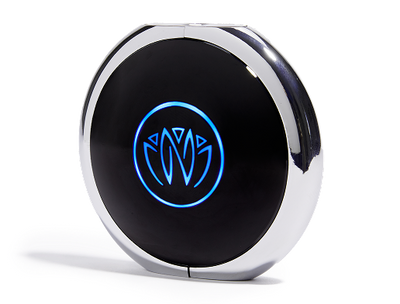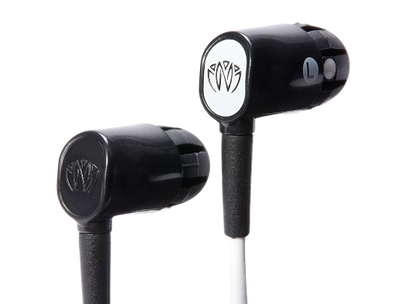Can you list all of the different parts of the ear? Don't worry—you're not being graded on your answer. And if you're like most people, beyond the ear canal and the ear lobe, the different parts of the ear (or at least their technical names and functions) aren't something you can list off the top of your head. But today we're going to cover the basic anatomy of the ear. At the same time, we'll place special focus on the auricular ear. Specifically, we'll explain the auricular ear release and what makes this one of the best vagus nerve hacks you've never heard of!
The Anatomy of the Ear
Let's begin with the basics and discuss the main components of the ear and what they're responsible for.
External, outer, or auricular ear
This is the part of the ear that's most visible to the human eye. The outside of the ear is called the pinna or auricle. We'll talk more about it when we get to the auricular ear in greater detail. The other part of the external ear is the external auditory canal or tube which connects the outer ear to the middle ear.
Middle ear (tympanic cavity)
The primary component of this part of the ear includes the ossicles, which are three small bones connecting to one another that help transmit sound waves to the inner ear: the malleus, incus, and stapes.
The middle ear also includes the eustachian tube. It serves as the link between the middle area and the back of the nose, helping equalize pressure in your middle ear. Without a balance of pressure here, sound waves can't transfer properly. Like the inside of the throat and nose, this tube is also lined with mucous.
Inner ear
And then we get to the inner ear. Its three primary components are cochlea, vestibule, and semicircular canals.
- Cochlea: This bone contains the nerves for hearing and helps transmit electrical impulses to the brain where it interprets them as individual frequencies of sound.
- Vestibule: This bony cavity in the ear is roughly 4 millimeters (mm) in size. It contains critical receptors for balance including helping to coordinate the position of the head and the movement of the eyes.
- Semicircular canals: These three tiny, fluid-filled tubes in your inner ear are part of the vestibular system and play an important role in balance. These tubes are known as the horizontal, superior and posterior semicircular canals.
Tympanic membrane (eardrum)
This membrane separates the middle ear from the external ear.
For today's purposes, since we're focusing on the auricular ear, let's talk a little more about it now. Then, we'll get into the vagus nerve and auricular ear release in greater detail.
Understanding the Auricular Ear
As the first part of the body to come into contact with auditory stimuli, the auricle plays a very important role for hearing. However, many people are unaware of the extent of its function, including how it relates to the vagus nerve. Before we get to that, let's talk more about the anatomy of the outer ear.
Most of the auricle contains cartilage, with the exception of the lobule (or ear lobe) that isn't supported by cartilage.
Read this description of the outer ear anatomy and reference the graphic to familiarize yourself with the auricle:
"The cartilaginous part of the auricle forms an outer curvature, known as the helix. A second innermost curvature runs in parallel with the helix – the antihelix. The antihelix divides into two cura; the inferoanterior crus, and the superoposterior crus.
In the middle of the auricle is a hollow depression, called the concha. It continues into the skull as the external acoustic meatus. The concha acts to direct sound into the external acoustic meatus. Immediately anterior to the beginning of the external acoustic meatus is an elevation of cartilaginous tissue – the tragus. Opposite the tragus is the antitragus."
Resource: https://teachmeanatomy.info/head/organs/ear/external-ear/
What is the Auricular Ear Release?
Now that you know more about the outer ear (and the anatomy of the ear in general), let's get back to the auricular ear release.
To understand this ear release, you first need to understand the vagus nerve. As the longest nerve in the body, it extends to virtually every system in the body, beginning at your brain and traveling down your body. When this nerve is stimulated and toned, it helps promote a brighter mood, more relaxation, better sleep, and a whole host of other benefits
As such, people have been using vagus nerve hacks for centuries to reap the rewards of stimulating it. Some of these hacks include things like cold water plunges, meditation, chanting, and yoga. For those looking for relief from seizures and other medical conditions, they might even consider the surgical implantation of an electrical device that stimulates the nerve.
Luckily, there are less invasive and more accessible ways to stimulate the vagus nerve, including with the use of vagus nerve stimulation headphones (we'll talk more about this before this blog post is done).
Another hack we're going to focus on today is the auricular ear release.
Interestingly, the outer ear is the part of the body where the vagus nerve is most directly accessible. It's here the vagus nerve sends its peripheral branch to, meaning it can transmit signals back to the brain, rather than interpreting from the brain outwards. As such, when you can stimulate your vagus nerve through the ear, it can then send signals back to the brain telling it to relax, release, and unwind.
With the auricular ear release, you're effectively stimulating the vagus nerve through the ear. As a result, you're telling your nervous system to rest and digest, promoting a sense of calm in your mind and body.
How to Perform the Auricular Ear Release
There are a few different ways to perform the auricular ear release on yourself. The best part about them is how non-invasive they are and that they can be done virtually anywhere at any time.
Before attempting these methods, it's helpful to assess your auricular ear and note any areas of tension. To do this, you'll gently pull each ear out to the side. Do this at the ear lobe, the middle of the ear, and the top of the ear. As you do so, pay attention to which ear and which area of the ear feels more tense, restricted, or painful.
Here are four methods, as explained by The Movement Paradigm:
Technique one
"Place your finger right under the ridge inside of your ear. You want to think about pressing backward. Gently move your finger in slow, small circles. There shouldn’t be any pain or discomfort, although it may feel a little different side to side. Sometimes this will trigger a sigh, swallow, or yawn. That is a sign of relaxation of the nervous system. You should likely feel a sense of calm."
Technique two
"The second technique would be to come down almost as if you’re going to go into the eardrum with your finger. Gently press backward toward the back of your head, and perform slow, gentle circles. This could be done for one minute or as long as you feel like it is helping and it’s comfortable."
Technique three
"The third technique is performed by placing your finger on the skin behind your ear. You will gently pull the skin up towards the direction of your head, moving the skin over the tissue. This is a myofascial release. Hold until you feel a release. This could feel like your finger can move easier and the skin feels more elastic. It could also trigger a relaxation response. You can hold this for one minute or longer if you find it to be beneficial."
Technique four
"The last technique is just gently pulling down on the ear lobe. This is considered a craniosacral technique, so it can have benefits for dizziness, headaches, and other neurological type symptoms. So, this is powerful for many different reasons, not just stimulating the vagus nerve."
Another Vagus Nerve Hack
As promised, let's touch on vagus nerve stimulating headphones before we go. Along with the auricular ear release, this is one of the most accessible and non-invasive methods of vagus nerve stimulation there is!
Xen is a patented electronic device that delivers gentle micropulses through headphones directly to the vagus nerve located in your ear. It pairs wirelessly to your Neuvana app, where you can customize your sessions. The result? Improved focus and calm anywhere you are.
Want to shop for your own? Click here to get started.
Did you learn a lot from this post about the auricular ear release?
Here are three more posts to read next:
- How to Improve Concentration: Brain Optimization Hacks for Peak Performance
- Holiday Stress Relief: Mindful Tips to De-Stress This Holiday Season
- Boost Your Cognitive Health With These Biohacks






